By Valerie Thomas, Georgia Institute of Technology
The United States is producing more oil and natural gas today than ever before, and far more than any other country. So, what roles did the Trump-Pence and Biden-Harris administrations play in this surge?
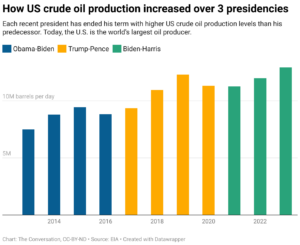
The answer might surprise you, given the way each has talked publicly about fossil fuels: former President Donald Trump embracing them, and President Joe Biden and Vice President Kamala Harris focusing on reducing fossil fuel use to fight climate change.
Under each of the three most recent presidencies, Republican and Democratic alike, U.S. oil and gas production was higher at the end of the administration’s term than at the beginning.
That production has both pros and cons. Together, oil and gas account for nearly three-quarters of U.S. energy consumption. Producing oil and gas in the U.S. provides energy security, and high production generally keeps prices down. Burning oil and gas, however, releases carbon dioxide into the air, contributing to climate change. And natural gas is mostly methane – another potent greenhouse gas.
As a scholar who works on both energy and public policy, I follow the federal government’s actions involving oil, gas and coal. With Trump and Harris facing off in the November presidential election, let’s take a look at how each influenced fossil fuel production and emissions.
Boosting and restricting oil and gas drilling
Both the Trump-Pence administration and the Biden-Harris administration took actions that supported additional oil and gas drilling. Both also took actions that restricted additional oil and gas drilling.
Trump has been aggressively pro-fossil fuels in his rhetoric and actions, dating back to his first run for office. Under his administration, the federal government leased more land for drilling in the Arctic National Wildlife Refuge, the National Petroleum Reserve-Alaska and in the Utah wilderness.
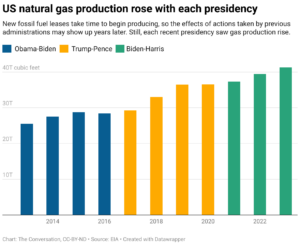
To further help the industry, Trump urged agencies to waive environmental reviews and loosen regulations in ways that could speed up permits for pipeline construction and other energy infrastructure.
The Trump administration also opened more U.S. coastal waters for oil and gas leasing, but Trump later rolled this back, banning coastal drilling for 10 years in the eastern Gulf of Mexico and the Atlantic coasts of Florida, Georgia and South Carolina. At the time, opposition to drilling in those states threatened several Republican candidates’ 2020 election bids.
The Biden-Harris administration focused on clean energy and climate change. It issued several regulations targeting fossil fuels, including efforts to reduce methane leaks from natural gas pipelines and increasing the royalties that companies pay for production on federal lands. In 2021, it issued a moratorium on new federal leases for oil and gas, but that was blocked by a federal judge.
However, the Biden-Harris administration also gave the go-ahead for the nation’s largest oil drilling operation, ConocoPhillips’ vast Willow project in Alaska. And the Inflation Reduction Act of 2022, considered the administration’s signature climate law, included additional oil and gas leasing and incentives to capture carbon dioxide for use in enhanced oil recovery.
Choices in one administration affect the next
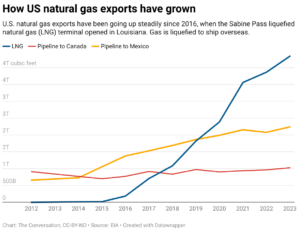
When land is leased for drilling, it takes some years for production to begin. So, the increased oil and gas production during the Biden administration is to some extent a result of leases issued during the Trump administration. Trump auctioned off the leases; the Biden administration signed the permits.
In many cases, presidents have little discretion and are essentially required to approve when permits meet the legal requirements.
Global events can also have large effects on production.
The COVID-19 pandemic reduced U.S. oil demand as activity slowed worldwide in 2020.
Russia’s invasion of Ukraine in 2022 led to greater energy demand from Europe. Natural gas has to be liquefied to ship it overseas, however, and the U.S. has limited export capacity. To send more supply to Europe, the U.S. had to reroute natural gas exports intended for other countries.
The Biden-Harris administration paused approvals for additional liquefied natural gas terminals in 2024, but a federal judge blocked the move.
What caused oil production to surge?
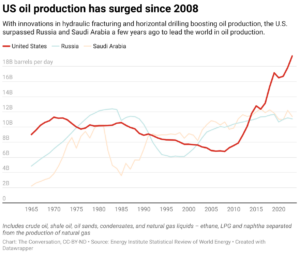
Drilling technology has been an important driver of the industry’s success.
U.S. oil production had reached a peak in 1970 and went into a slow decline that lasted more than three decades. It was widely believed that the U.S. had pumped its best reservoirs and that the country would be inexorably dependent on foreign oil.
Then, in the early 2000s, innovations in hydraulic fracturing and horizontal drilling changed everything. These techniques gave drillers access to previously hard-to-reach fossil fuels and opened up opportunities for oil and gas drilling at lower cost and in greater quantities. Since around 2009, U.S. oil production has surged.
Natural gas followed a similar trajectory. U.S. natural gas production had peaked in 1972 and leveled off. But with fracking, natural gas production has risen since around 2005. Trump supports fracking. Harris opposed fracking in the past, but she told CNN in August 2024 that she won’t ban it.
What about coal?
U.S. coal production is a different story. It peaked in 2008 and has been going down sharply since then.
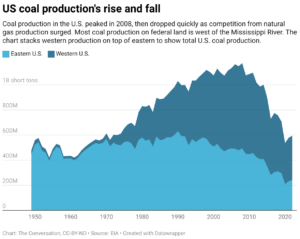
Coal is more susceptible to government actions than oil and gas – 40% of it is produced on federal land, compared with 24% for oil and 11% for natural gas. And it has seen federal policy swings.
For example, in 2016, then-President Barack Obama banned new coal-mining leases in the Powder River Basin in Montana and Wyoming, where the majority of coal production on federal land takes place. The Trump administration lifted that freeze a year later, but a court ordered a pause of Trump’s move. The ban was eventually revoked by a court during the Biden administration. Then the Biden administration again ended new leases in the Powder River Basin.
But coal’s decline was also about economics. As natural gas became cheaper, it increasingly replaced coal in U.S. electricity production.
The decrease in coal production is the main reason U.S. carbon dioxide emissions have been falling even as fossil fuel production rises. Rising renewable energy production and increasing efficiency in some technologies have also helped cut emissions.
The bottom line
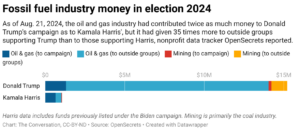
Trump can take credit for allowing more leases for oil and gas drilling. The Biden-Harris administration, while it issued permits for oil and gas drilling and production increased on its watch, established several rules to limit greenhouse gas emissions from fossil fuels.
Presidents’ actions can matter for the industry’s future, but the major factors in U.S. oil and gas production so far have been increased production efficiency, increased global demand and the lower cost of natural gas compared with coal.![]()
Valerie Thomas is a professor of industrial engineering at the Georgia Institute of Technology. Banner photo: An offshore oil drilling platform in the Gulf of Mexico. (Bureau of Safety and Environmental Enforcement via Wikimedia Commons)
This article is republished from The Conversation under a Creative Commons license. Read the original article.
Sign up for The Invading Sea newsletter by visiting here. If you are interested in submitting an opinion piece to The Invading Sea, email Editor Nathan Crabbe at ncrabbe@fau.edu.



